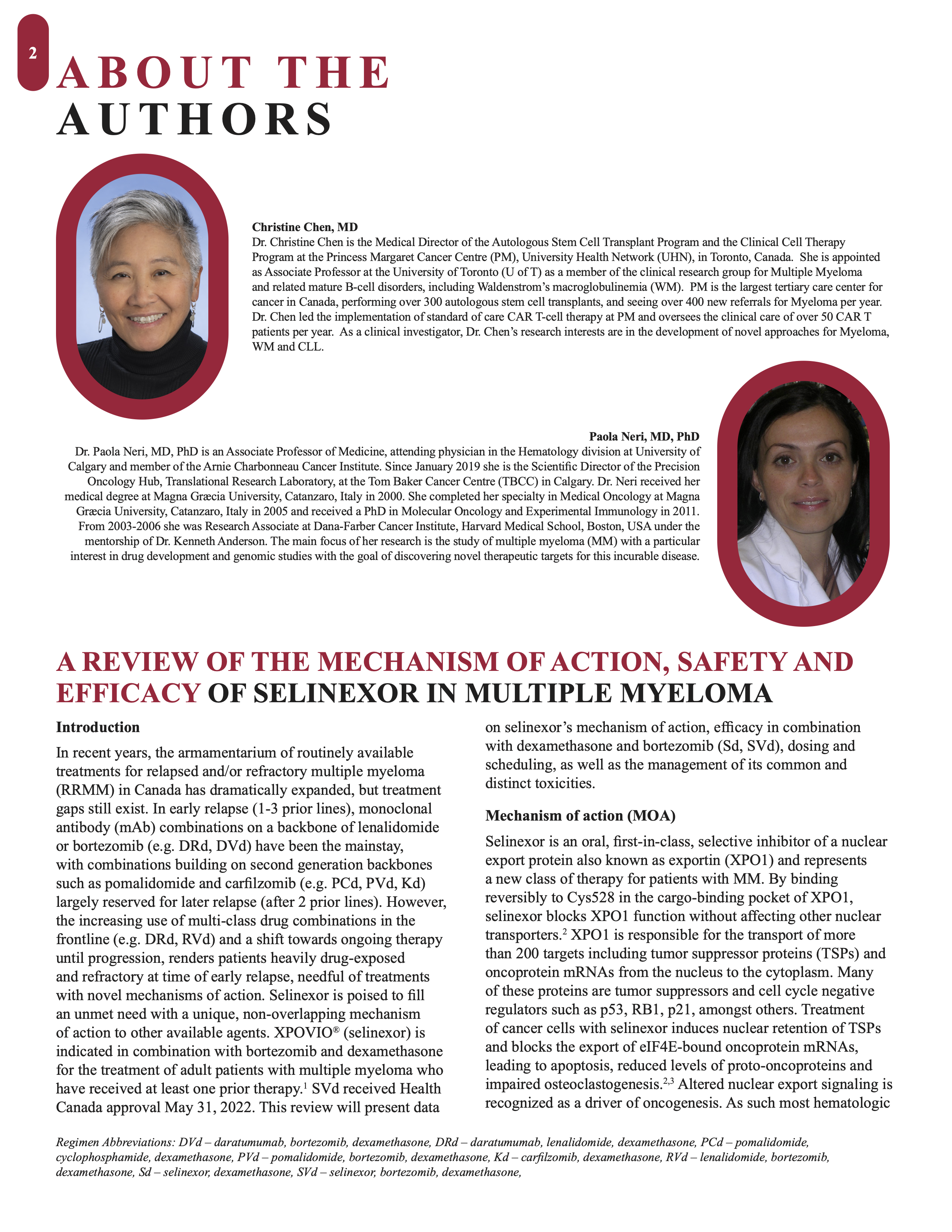A review of the mechanism of action, safety, and efficacy of selinexor in multiple myeloma
DOI:
https://doi.org/10.58931/cht.2023.2S0326Abstract
In recent years, the armamentarium of routinely available treatments for relapsed and/or refractory multiple myeloma (RRMM) in Canada has dramatically expanded, but treatment gaps still exist. In early relapse (1-3 prior lines), monoclonal antibody (mAb) combinations on a backbone of lenalidomide or bortezomib (e.g. DRd, DVd) have been the mainstay, with combinations building on second generation backbones such as pomalidomide and carfilzomib (e.g. PCd, PVd, Kd) largely reserved for later relapse (after 2 prior lines). However, the increasing use of multi-class drug combinations in the frontline (e.g. DRd, RVd) and a shift towards ongoing therapy until progression, renders patients heavily drug-exposed and refractory at time of early relapse, needful of treatments with novel mechanisms of action. Selinexor is poised to fill an unmet need with a unique, non-overlapping mechanism of action to other available agents. XPOVIO® (selinexor) is indicated in combination with bortezomib and dexamethasone for the treatment of adult patients with multiple myeloma who have received at least one prior therapy. SVd received Health Canada approval May 31, 2022. This review will present data on selinexor’s mechanism of action, efficacy in combination with dexamethasone and bortezomib (Sd, SVd), dosing and scheduling, as well as the management of its common and distinct toxicities.
References
XPOVIO product monograph. FORUS Therapeutics Inc. 2022 May 31. Available from: https://pdf.hres.ca/dpd_pm/00066090.pdf
Gravina GL, Senapedis W, McCauley D, Baloglu E, Shacham S, Festuccia C. Nucleo-cytoplasmic transport as a therapeutic target of cancer. J Hematol Oncol. 2014 Dec 5;7:85. DOI: https://doi.org/10.1186/s13045-014-0085-1
Tan DSP, Bedard PL, Kuruvilla J, Siu LL, Razak ARA. Promising SINEs for embargoing nuclear-cytoplasmic export as an anticancer strategy. Cancer Discov. 2014 May;4(5):527-37. DOI: https://doi.org/10.1158/2159-8290.CD-13-1005
Schmidt J, Braggio E, Kortuem KM, Egan JB, Zhu YX, Xin CS, et al. Genome-wide studies in multiple myeloma identify XPO1/CRM1 as a critical target validated using the selective nuclear export inhibitor KPT-276. Leukemia. 2013 Dec;27(12):2357-65. DOI: https://doi.org/10.1038/leu.2013.172
Tai YT, Landesman Y, Acharya C, Calle Y, Zhong MY, et al. CRM1 inhibition induces tumor cell cytotoxicity and impairs osteoclastogenesis in multiple myeloma: molecular mechanisms and therapeutic implications. Leukemia. 2014 Jan;28(1):155-65. DOI: https://doi.org/10.1038/leu.2013.115
Turner JG, Kashyap T, Dawson JL, Gomez J, Bauer AA, et al. XPO1 inhibitor combination therapy with bortezomib or carfilzomib induces nuclear localization of IκBα and overcomes acquired proteasome inhibitor resistance in human multiple myeloma. Oncotarget. 2016 Nov 29;7(48):78896-78909. DOI: https://doi.org/10.18632/oncotarget.12969
Masood A, Iqbal Q, Ehsan H, Davis JA, Hansen DK, Hashmi H. Efficacy and safety of selinexor-based regimens for relapsed/refractory multiple myeloma: a systematic review of literature. Ann Hematol. 2022 Dec;101(12):2601-2610. DOI: https://doi.org/10.1007/s00277-022-04999-1
Kashyap T, Argueta C, Aboukameel A, Unger TJ, Klebanov B, et al. Selinexor, a Selective Inhibitor of Nuclear Export (SINE) compound, acts through NF-κB deactivation and combines with proteasome inhibitors to synergistically induce tumor cell death. Oncotarget. 2016 Nov 29;7(48):78883-78895. DOI: https://doi.org/10.18632/oncotarget.12428
Tagoug I, Neri P, Slaby J, Babich J, Simms J, et al. XPO1 inhibition disrupts ribosomal subunits assembly and induces multiple myeloma (MM) cell death. Blood. 2013;122(21):3165. DOI: https://doi.org/10.1182/blood.V122.21.3165.3165
Grosicki S, Simonova M, Spicka I, et al. Once-per-week selinexor, bortezomib, and dexamethasone versus twice-per-week bortezomib and dexamethasone in patients with multiple myeloma (BOSTON): a randomised, open-label, phase 3 trial. Lancet. 2020;396(10262):1563-73. DOI: https://doi.org/10.1016/S0140-6736(20)32292-3
Bahlis NJ, Sutherland H, White D, Sebag M, Lentzsch S, et al. Selinexor plus low-dose bortezomib and dexamethasone for patients with relapsed or refractory multiple myeloma. Blood. 2018 Dec 13;132(24):2546-2554. DOI: https://doi.org/10.1182/blood-2018-06-858852
XPOVIO product monograph. FORUS Therapeutics Inc. 2022 May 31. Available from: https://pdf.hres.ca/dpd_pm/00066090.pdf
Bahlis NJ, Richard S, White DJ, Grosicki S, Chen C, et al. Effects of Cytogenetic Risk on Outcomes in Multiple Myeloma Treated with Selinexor, Bortezomib, and Dexamethasone (XVd). Presented at: ASH 2021. 63rd American Society for Hematology Annual Meeting; 2021 Dec 11-14. Abstract 1634. DOI: https://doi.org/10.1182/blood-2021-146324 DOI: https://doi.org/10.1182/blood-2021-146324
Bonolo de Campos C, Meurice N, Petit JL, Polito AN, Zhu YX, Wang P, et al. “Direct to Drug” screening as a precision medicine tool in multiple myeloma. Blood Cancer J. 2020 May 11;10(5):54. DOI: https://doi.org/10.1038/s41408-020-0320-7
Turner JG, Dawson J, Cubitt CL, Baz R, Sullivan DM. Inhibition of CRM1-dependent nuclear export sensitizes malignant cells to cytotoxic and targeted agents. Semin Cancer Biol. 2014;27:62-73. DOI: https://doi.org/10.1016/j.semcancer.2014.03.001
Chen C, Siegel D, Gutierrez M, Jacoby M, Hofmeister CC, Gabrail N, et al. Safety and efficacy of selinexor in relapsed or refractory multiple myeloma and Waldenstrom macroglobulinemia. Blood. 2018 Feb 22;131(8):855-863. DOI: https://doi.org/10.1182/blood-2017-08-797886
Chari A, Vogl DT, Gavriatopoulou M, Nooka AK, Yee AJ, et al. Oral selinexor–dexamethasone for triple-class refractory multiple myeloma. N Engl J Med. 2019 Aug 22;381(8):727-738.
Auner HW, Gavriatopoulou M, Delimpasi S, Simonova M, Spicka I, et al. Effect of age and frailty on the efficacy and tolerability of once-weekly selinexor, bortezomib, and dexamethasone in previously treated multiple myeloma. Am J Hematol. 2021 Jun 1;96(6):708-718. DOI: https://doi.org/10.1002/ajh.26172
Hing ZA, Fung HYJ, Ranganathan P, Mitchell S, El-Gamal D, et al. Next-generation XPO1 inhibitor shows improved efficacy and in vivo tolerability in hematological malignancies. Leukemia. 2016 Dec;30(12):2364-2372. DOI: https://doi.org/10.1038/leu.2016.136
Sanchez L, Leleu X, Beaumont JL, Yu H, Hudgens S, et al. Peripheral neuropathy symptoms, pain and functioning in relapsed or refractory multiple myeloma patients treated with selinexor, bortezomib, and dexamethasone. Blood. 2020;136(Suppl 1):39-41. DOI: https://doi.org/10.1182/blood-2020-141319
Gavriatopoulou M, Chari A, Chen C, Bahlis N, Vogl DT, et al. Integrated safety profile of selinexor in multiple myeloma: experience from 437 patients enrolled in clinical trials. Leukemia. 2020 Sep;34(9):2430-2440. DOI: https://doi.org/10.1038/s41375-020-0756-6
Machlus KR, Wu SK, Vijey P, Soussou TS, Liu ZJ, Shacham E, et al. Selinexor-induced thrombocytopenia results from inhibition of thrombopoietin signaling in early megakaryopoiesis. Blood. 2017 Aug 31;130(9):1132-43. DOI: https://doi.org/10.1182/blood-2016-11-752840

Published
How to Cite
Issue
Section
License
Copyright (c) 2023 Canadian Hematology Today

This work is licensed under a Creative Commons Attribution-NonCommercial-NoDerivatives 4.0 International License.
